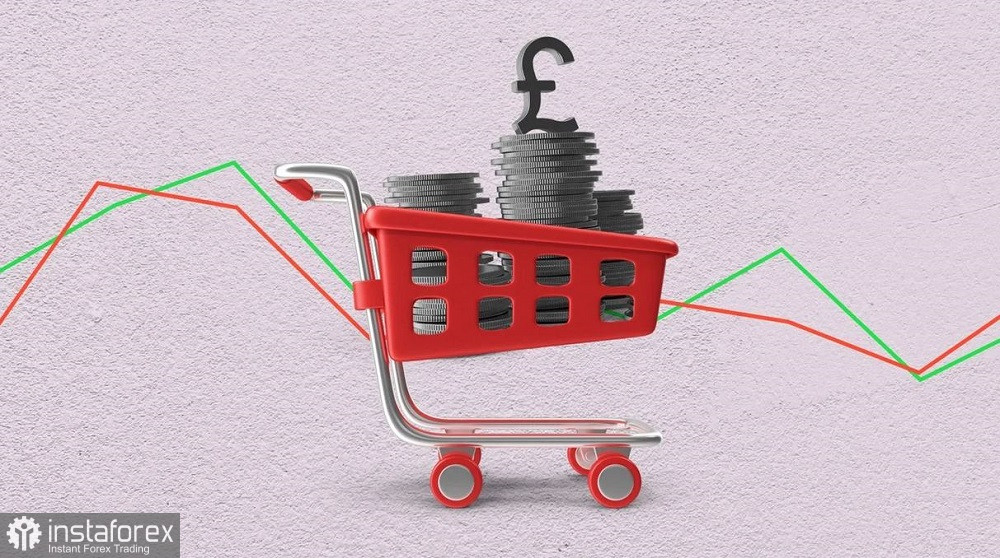Dollar pairs are frozen in anticipation of key releases this week, primarily focusing on inflation reports. It is worth noting that not only the United States will publish inflation growth data for October, but also the United Kingdom. Therefore, the current calmness in the GBP/USD pair is the calm before the storm. The report on CPI growth in the United States will be published today, and the report on CPI growth in Britain will be released tomorrow. Given this circumstance, it is not advisable to rush to trading conclusions based solely on the American release. British figures can also have a significant impact on the GBP/USD pair, especially if the actual result differs from the forecast values.
Recall that following the November meeting, the Bank of England did not raise interest rates but allowed for a tightening of monetary policy at one of the subsequent meetings in the event of "more sustained inflationary pressure than currently expected." In addition, the central bank revised its forecasts for reaching the target inflation level. If previously the regulator assumed that CPI would return to the two percent level by the second quarter of 2025, now this time horizon has been shifted to the end of 2025.

In other words, the pound received some support from the central bank, but this support had an advanced nature, so to speak. The Bank of England did not rule out further rate hikes, but only if inflation starts to pick up again. However, judging by preliminary forecasts, in October, the main inflation indicators are expected to show a sharp decline. Therefore, if tomorrow's report is even at the forecast level, the pound will come under significant pressure. In this case, the rise of GBP/USD will be possible only if the U.S. dollar weakens overall (which may negatively react to its inflation growth data release in the U.S.).
According to the forecasts of the majority of experts, the overall consumer price index in the UK will reach 4.7% in annual terms in October, the weakest growth rate since September 2021. For comparison, in the previous month, the overall CPI was at 6.7%. The core consumer price index, excluding energy and food prices, is expected to show a similar downward trend. According to forecasts, this indicator will decline to 5.7% year-on-year in October (the lowest value since March 2022). In September, the core CPI was at 6.1%.
The retail price index, used by British employers in salary negotiations, should also set a multi-month low. In September, this indicator was at 8.9% on an annual basis, while in October, it is expected to decrease immediately to 6.6%! The producer price index has been in negative territory for the third consecutive month, and in October, it may deepen further to -3.3% year-on-year (the lowest value since August 2020). The producer output price index is also expected to sharply decrease from -0.1% to -1.1% year-on-year. This component of the report has been in negative territory since July of this year.
As we can see, the forecasts of the majority of experts do not bode well for the British currency. It is important to emphasize that de facto, the English regulator has maintained the parameters of monetary policy unchanged and declared the preservation of the status quo in the future. And although, formally, the Bank left the door open for another interest rate hike, the corresponding conditions are required for this. Primarily, this involves the growth of key inflation indicators. Therefore, if tomorrow's reports come out at least at the forecast level (not to mention the "red zone"), the probability of an interest rate hike by the Bank of England in the near future (at least in the context of December-January) will practically drop to zero.
It is also worth reminding that the indicators of the UK economy stagnated in the third quarter of this year. Data released last week showed that the indicators of the service sector (which accounts for about 80% of the total GDP) decreased by 0.1% in the third quarter after stagnating in the second quarter. The manufacturing sector's production volume stagnated from July to September compared to the previous quarter. And although Andrew Bailey, following the November meeting, reminded that the central bank's mandate is price stability, "not preventing a recession," the Bank of England will still have to take into account the results of the third quarter when deciding on the interest rate. And if inflation predictably slows down in October, I believe the question of tightening monetary policy will be definitively removed from the agenda—at least in the context of the next two meetings.
Thus, the sluggish rise of GBP/USD today should not be trusted, as the pair will enter a zone of price turbulence in the near future—and judging by preliminary forecasts, this turbulence may not be in favor of the British currency. It is advisable to make trading decisions on the pair after the release of inflation growth data in the United Kingdom.
 English
English 
 Русский
Русский Bahasa Indonesia
Bahasa Indonesia Bahasa Malay
Bahasa Malay ไทย
ไทย Español
Español Deutsch
Deutsch Български
Български Français
Français Tiếng Việt
Tiếng Việt 中文
中文 বাংলা
বাংলা हिन्दी
हिन्दी Čeština
Čeština Українська
Українська Română
Română

